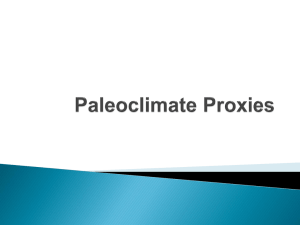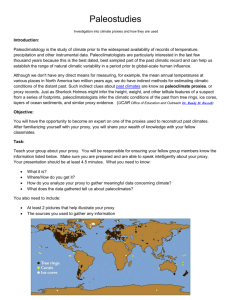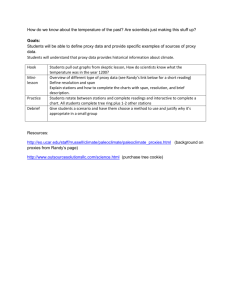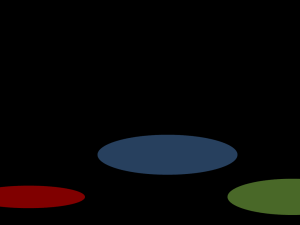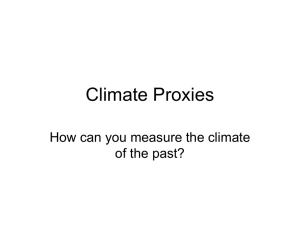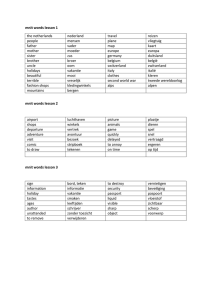How do we know about the climate 150,000 years ago?
advertisement
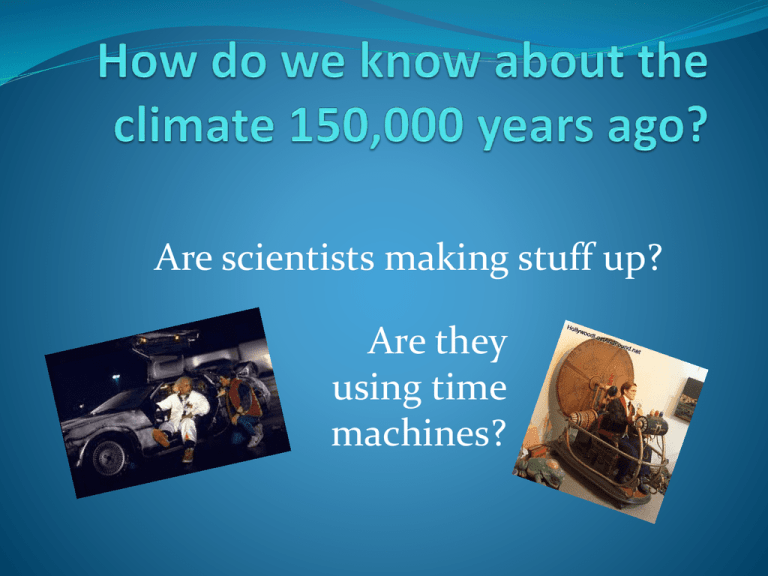
Are scientists making stuff up? Are they using time machines? Climate data of the past Actual Measurements Humans have been recording climate using instruments for only the past ~100-200 years Instruments to record temperature, wind, precipitation, etc Climate data of the past Historical Records •Old journals describing natural disasters •Agricultural records, for example when grapes were harvested •Old records of when different plants were in bloom •Voyage records Bradley, R.S., 1991. Pre-instrumental climate: how has climate varied during the past 500 years? Garcia et al. Manila Galleons Voyage Records Climate data of the past Proxies Paleoclimatologists use paleoclimate proxies. proxy: An indicator of past climate. A proxy (meaning “substitute”) is an indirect measure of climate, as opposed to direct measures such as reading temperature from a thermometer. Just as Sherlock Holmes might infer the height, weight, and other telltale features of a suspect from a series of footprints, paleoclimatologists infer the climatic conditions of the past from tree rings, ice cores, layers of ocean sediments, fossils, and similar proxy evidence. Introduction to proxy data video Span and Resolution Span = how far into the past the proxy information goes Resolution = how specific the climate information is in terms of years A higher resolution ca n give you information about a specific year. A lower resolution will show long-term changes that occur over many years. Span and Resolution of Proxy Sources Time Limits of Various Proxy Data (years past) Where does proxy sampling occur? location of proxy data http://michigantoday.umich.edu/2009/11/vostok-graph.jpg Ice Cores Jim White: Stable Isotope Lab @ CU http://saima-tutkimus.fi/saimapictures/kiekkoisov.jpg http://www.ncdc.noaa.gov/paleo/ctl/images/16thchron2.jpg Tree Rings Speleothems http://upload.wikimedia.org/wikipedia/en/a/a1/Labeled_speleothems.jpg http://www.windows2universe.org/ea rth/climate/images/stalagmites_sm.jp g http://www.ncdc.noaa.gov/paleo/pubs/smith2006/fig1.jpg Pollen http://lh5.ggpht.com/_j1cdMMQnYns/TMLGrbaJP_I /AAAAAAAAJMU/2CNdQce5DKw/lavender-pollengrain--lavandula-dentata--80200172-m%5B4%5D.jpg Canadian model Hadley model http://www.climateshifts.org/wp-content/uploads/2011/02/Bellwood-et-al-Fig-1.jpg Coral http://switchboard.nrdc.org/blogs/fbeinecke/Bleached.coral.jpg Historical Combining all of the proxy data Conclusion http://scienceinthetriangle.org/wp-content/uploads/2011/02/spaghetti-climate-graph.jpg Proxy data source 1 Tree Rings 2 Corals 3 Packrat Middens 4 Lake and Ocean Sediments 5 Pollen in lake a sediments 5 Fossils b 6 Ice Cores Description of how it is collected Where is it collected? How far back does it go? (span) Resolution Station 1 – Dendochronology (Tree Rings) 1. Read the background information on tree rings. (see printed text) 2. Then click on the link below, You be the Dendochronologist and practice making different width rings and matching exising data. Follow the instructions on the page. 3. Complete your chart. You be the dendochronologist Station 2 - Corals 1. Read the text and watch the video. Click on coral video to link to the page. coral video 2. Watch a short video (no sound) to see how the coral cores are collected. 3. Complete your chart coral core collection (no sound) How we measure past sea level from Acropora palmata coral corals Acropora palmata is a coral that only grows in water that is less than 5 meters deep. Scientist drilling for coral Therefore if it is found in a location, you can infer that that location was once under 5 meters or less of water. Stations 3 - Packrat Middens Packrat Middens Packrat Middens Packrats, as their name implies, constantly collect all kinds of materials from their surroundings. Their collections, called "middens", provide clues to the past climates of the region. Packrat middens are clumps of vegetation, insects, remains of vertebrates, and other materials cemented together by crystallized packrat urine (referred to as amberat). These rock-hard deposits can be more than 20,000 years old. Packrat making a midden Source: San Diego Natural History Museum A sample of packrat midden from Red Creek (RC2) that dates to 3320 B.P. Needles of lodgepole pine were recovered from this midden found in the lower basin. A scientist examines a packrat midden. Credit:W.G. Spaulding and National Oceanic and Atmospheric Administration Paleoclimatology Program/Department of Commerce Station 4 –Lake and Ocean Sediments 1. Watch the video and read the text. Click on the lake sediment proxy link to view the video. Lake Sediment proxy data video and text more information and pictures on lake sediments 2. Complete your chart. Collecting a lake sediment core Station 5 Lake Sediments and Pollen Station 6 – Ice Cores Debrief 1. Which proxy data would be appropriate for determining climate 1.5 million years ago? 2. Which proxy data would be appropriate for determining the climate around Hawaii? 3. If you were wondering if there was an ocean in Colorado, which type of proxy data would be appropriate? 4. Looking at your graphs, which type of proxies might have been used and why? 5. In your journal, explain to a skeptic: “How scientists know about the climate of the past.” Ice: It’s more than just frozen water What Can Ice Cores Tell us about Past Climate? Jim White short version video of ice cores Introduction Background Earth’s climate changes. Although there is debate over what causes this change, scientists agree that Earth’s climate has changed and continues to change over time. One way to learn about these changes is through the study of glacial ice cores. Ice cores create a layered historical record of the climate over time. Scientists drill deeper into older layers of ice; sometimes to a depth of over 3,500 meters (2.2 miles). By performing physical and chemical tests on ice cores, scientists can create a snapshot of the Earth at single points in time. Atmospheric gases, from hundreds to thousands of years ago, are trapped as small bubbles within the ice. Measurements of gases, including carbon dioxide, paint a picture of the atmosphere at the time the gases were trapped. How are they collected? Figure 1. Ice Core Sampling. Image credit: Reto Stöckii, NASA GSFC An ice core section Where are they collected? map of drilling sites Side view showing dust & ash layers (from drought years and volcanoes) Melting a core sample to release the trapped gases
